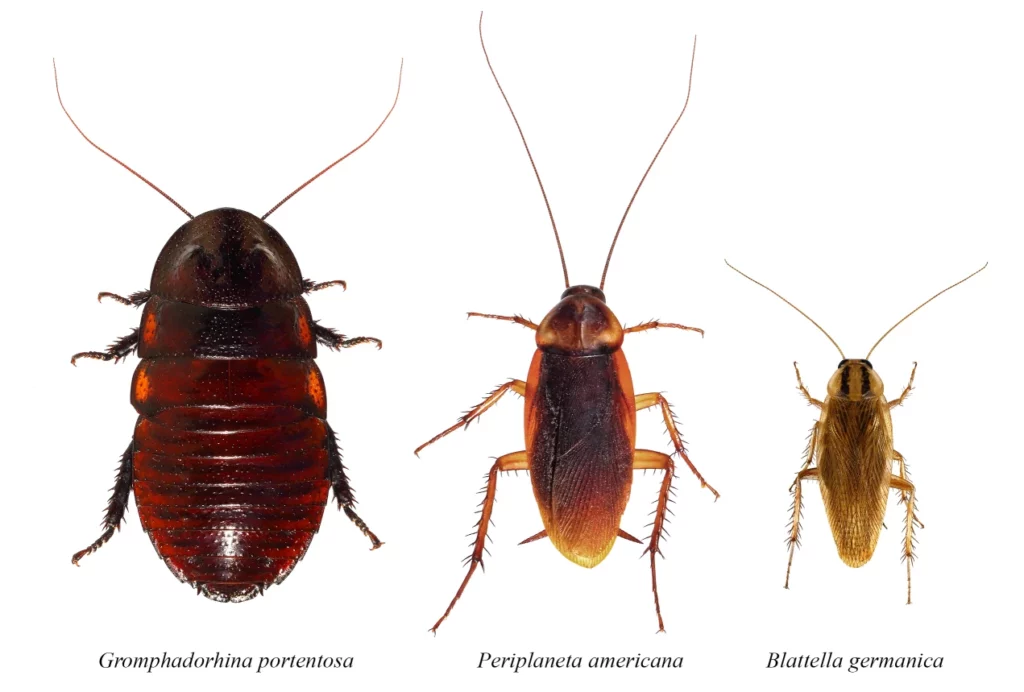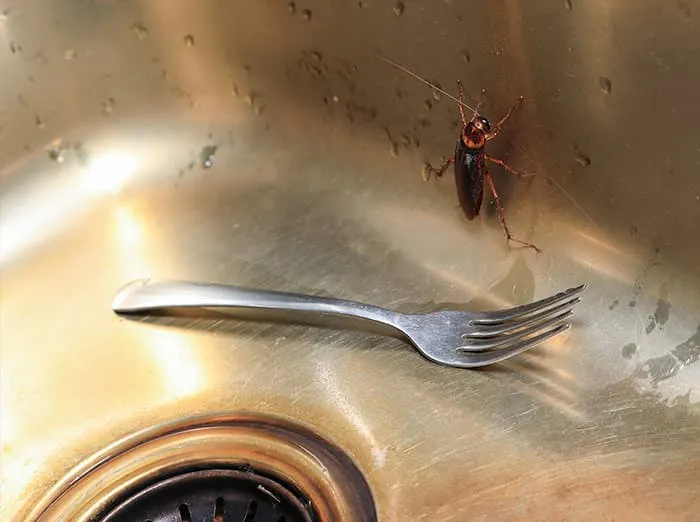Cockroach Treatments in Florida
Exterminator Services for Daytona Beach and Ormond Beach
Florida’s balmy climate, noted for mild winters, high humidity, and sunshine, entices visitors and residents year-round – but these conditions also make it ideal for cockroaches. Whether it’s German roaches nesting in kitchens or larger American roaches appearing near drains, these pests thrive when food, moisture, and shelter abound. In Daytona Beach, and the neighboring community of Ormond Beach, roach sightings can escalate quickly if overlooked, threatening occupant comfort, sanitation, and property image. This service page highlights why roaches flourish in Florida, how to detect an early infestation, and why hiring a professional cockroach exterminator for cockroach treatments is the most assured way to eliminate them. Acting swiftly, instead of ignoring initial droppings or spotting roaches at night, spares you from deeper contamination, occupant complaints, and a lengthier remediation process down the line.
Why Cockroaches Flourish in Florida

- Mild, Short Winters
In colder regions, sustained sub-freezing temperatures kill off roach populations or stop breeding until spring. Florida’s winter seldom hits these prolonged cold spells, allowing cockroaches to remain active, feed, and reproduce nearly year-round. Indoors, climate-controlled environments offer stable warmth, and roaches can breed indefinitely if occupant vigilance is weak. - High Humidity and Moisture
Many cockroach species require damp areas to thrive. Florida’s frequent rainfall and muggy air ensure ideal humidity levels. Damp corners under sinks or behind toilets, condensation near air-conditioning lines, or leaky pipes in basements become prime roach hideouts. Neglected plumbing or daily occupant routines may inadvertently let roaches find steady water sources. - Minimal Seasonal Dormancy
In cooler states, roaches often experience slow breeding cycles or partial dormancy when freezing weather lasts months. In southwestern Florida – including Daytona Beach and Ormond Beach – no extended freeze kills or stifles them. A small roach infiltration can balloon rapidly if occupant housekeeping or professional solutions do not intervene. - Easy Food Accessibility
Roaches are opportunistic feeders, devouring leftover crumbs, open food containers, or unsealed trash. In a busy household or commercial setting, minor oversights – like leaving dishes overnight or neglecting kitchen cleanliness – allow roaches daily feasts. With no seasonal break, occupant routines seldom disrupt roach survival beyond the scope of targeted pest treatments. - Frequent Human Traffic
With occupant or traveler transitions, short-term rentals, and local businesses receiving shipments, roaches may ride along in cardboard boxes, produce crates, or secondhand furnishings. Introduced to new environments, roaches hide behind appliances, in wall cavities, or under floors, expanding their territory unless occupant detection or professional attention removes them.
Telltale Signs of a Cockroach Infestation
- Droppings
Different roach species leave distinct droppings. German roaches produce pepper-like specks or smears, while larger roaches deposit cylindrical pellets. Fresh droppings are typically dark and moist. Discovering clusters in cupboards, on countertops, or behind appliances confirms roach movement in these areas. - Egg Casings (Oothecae)
Roaches lay egg capsules holding multiple eggs, often stuck to hidden surfaces or dropped in corners. Brownish, segmented, or pill-shaped, these oothecae indicate active breeding. Some roach species carry egg capsules until hatching, so not all get left behind, but finding any is a red flag. - Musty or Oily Odor
Larger or prolonged infestations can yield a distinct, musty scent. Even smaller roach populations, if left unaddressed, build up an oily or unpleasant smell. Occupants detecting unexplained odors in cabinets or near damp corners may want to check for droppings or roach activity. - Nocturnal Sightings
Flicking on lights in a dark kitchen or bathroom and seeing roaches scatter strongly suggests a growing roach issue. Roaches generally forage at night; spotting them during daylight often indicates overpopulation forced some into more exposed areas, underscoring a potentially severe infestation. - Smear Marks
In humid surroundings, roaches may leave smeary streaks on walls or corners they frequent. These lines typically appear near floor-level or hidden corners. Repeated occupant discovery of these marks near sinks or behind refrigerators verifies frequent roach traffic.
Why Quick Cockroach Treatments Are Critical
- Health and Sanitation
Roaches can transmit bacteria onto surfaces, utensils, or stored food, posing occupant health concerns. Their droppings can spark allergies or aggravate asthma in susceptible individuals. Immediate occupant or professional solutions preserve clean environments, safeguarding families or clientele. - Rapid Reproduction
Certain roach species, especially German roaches, multiply quickly if left uncontained. A minor presence can form a significant infestation in just weeks. Early occupant detection – noticing a few roaches or droppings – followed by robust extermination measures, halts larger outbreaks spanning multiple rooms. - Property Reputation
For restaurants, hotels, or short-term rentals in Daytona Beach, occupant sightings or online reviews describing roaches undermine brand image. Even in homes, occupant embarrassment or daily agitation arises when encountering roaches at mealtime or opening cupboards to find droppings. - Daily Stress
Co-existing with roaches undermines occupant comfort – from discovering droppings in drawers to fearing roach scurries at night. Eliminating them comprehensively lets occupants focus on daily routines without scanning corners for unexpected bugs.

Why a Professional Exterminator is Essential
- Thorough Inspection
A cockroach exterminator reviews kitchens, bathrooms, basements, or yard perimeters to detect droppings, egg casings, or roach runways. Identifying which species is present (German, American, smoky-brown, etc.) clarifies how best to place traps or baits, ensuring coverage of all roach hideouts. - Effective Baiting and Trapping
DIY sprays can scatter roaches deeper or push them behind walls if misapplied. Professionals strategically apply gel baits or station insect growth regulators where roaches feed or hide, guaranteeing roaches return to nests carrying toxic substances that kill colonies entirely. - Exclusion and Sanitation
An occupant or professional approach that addresses roach attractions—like water leaks, leftover crumbs, or open trash—works hand-in-hand with extermination. Failing to correct housekeeping or structural flaws sets the stage for recurring roach intrusion. - Reduced Chemical Risk
Professionals minimize occupant or pet chemical exposure by focusing insecticides or baits exactly where roaches frequent: behind appliances, near damp pipes, or cracks in baseboards. Occupants typically wait for dryness before reentering newly sprayed zones, quickly resuming normal routines. - Follow-Up Assurance
Since roach egg casings may hatch weeks after adults die, occupant or scheduled re-checks confirm no new wave emerges. If occupant sightings continue, additional spot or perimeter treatments finalize occupant relief, guaranteeing roaches do not regain a foothold.
Methods for Cockroach Extermination
- Inspection and Mapping
Professionals examine every suspected roach runway—kitchen cabinets, behind stoves, near water lines—documenting droppings or egg capsules to determine species. Locating the heaviest clusters ensures targeted coverage, from baseboards to hidden corners. This clarity shapes an individualized plan of attack. - Gel Baits and Bait Stations
Gel baits are especially effective for species like German roaches. Placing gel in cracks or corners lures roaches to consume slow-acting poison, spreading it back to the nest. Bait stations near damp areas or behind appliances also achieve broad colony impact, requiring minimal occupant oversight. - Insect Growth Regulators (IGRs)
By applying IGRs around roach travel routes, professionals inhibit egg or nymph development. These products prevent roach generations from reaching adulthood, crippling a colony’s capacity to spawn new waves. Coupled with adulticides, IGR usage ensures thorough coverage from egg to adult. - Residual Sprays
Directed insecticides along wall-floor junctions, near water sources, or behind large appliances remain active for days or weeks. Roaches crossing these sprayed surfaces pick up lethal doses. Occupants typically vacate only until the product dries, swiftly resuming daily life while roaches face lethal contact. - Dust Applications
In deeper wall voids or behind immovable fixtures, applying insecticidal dust helps kill roaches that brush against it. Because roaches groom themselves, they ingest the dust, killing them and, often, other roaches in the nest. This long-lasting measure complements baits or sprays for hidden nest zones.
Serving Daytona Beach and Ormond Beach
Daytona Beach: Renowned for beaches, motor racing, and tourism, Daytona Beach sees occupant transitions or short-term rentals that might inadvertently bring roaches in personal luggage or used furnishings. Thorough occupant housekeeping—like sealing cereals or wiping counters—and expert roach solutions hamper infestations spreading across multiple floors or units.
Ormond Beach: Mixing coastal charm with suburban growth, Ormond Beach merges older homes and new properties. Roaches sometimes exploit older structures’ cracks or minimal occupant routines, quickly establishing breeding zones behind walls or in damp corners. Occupant synergy—like daily trash disposal—and skilled pest control ensure no roach stronghold remains.

Why Our Cockroach Solutions Shine
- Florida-Specific Approach
Because southwestern Florida rarely experiences roach-slowing cold spells, occupant-based cleaning—like discarding food scraps nightly—plus targeted baits or insect growth regulators ensures roaches have nowhere to nest or feed comfortably, year-round. - Strategic, Environmentally Conscious Application
We place baits or insecticidal sprays exactly where roaches hide—like under sinks or behind refrigerators—limiting occupant exposure to chemicals. Occupants can often stay on-site, waiting for dryness before returning to normal usage. - Emphasis on Prevention
After removing visible roaches, occupant housekeeping or minor repairs (like sealing cracks, fixing leaks) denies roaches future harborages. This occupant synergy cements roach-free conditions, preventing re-infiltration. - Follow-Up Verification
Because roach egg casings can hatch weeks later, occupant or professional re-checks confirm no new wave emerges. If occupant sightings persist, further spot or perimeter treatments finalize occupant comfort, ensuring no returning roach presence lingers in hidden corners.
Next Steps
Spotting droppings behind the kitchen stove, seeing roaches scurry when you flip on lights, or sensing a musty odor in damp cupboards? Contact us to learn more or schedule your service. Our cockroach treatments in Daytona Beach and Ormond Beach attack roach populations at every life stage—egg, nymph, and adult—restoring occupant calm and sanitation. Rely on a professional exterminator approach, sparing you guesswork while thoroughly eradicating hidden colonies from corners, behind appliances, or wall voids.
Immediate occupant action spares you from advanced infestations that tarnish brand image, occupant trust, or daily living. Through occupant housekeeping—like promptly cleaning spills, sealing cereals, or discarding clutter—and specialized trap or bait station usage, roaches meet lethal barriers at each turn. Freed from the presence of roaches rummaging under sinks or behind counters, southwestern Florida property owners fully embrace Florida’s mild winters and vibrant outdoor lifestyle, confident no unwelcome bugs overshadow their day-to-day comforts.
Maintaining a Roach-Free Property
- Store Food Securely: Use airtight containers for grains, snacks, or pet kibble. Wiping counters nightly and discarding leftover scraps starves roaches seeking easy meals.
- Eliminate Water Sources: Fix leaky faucets, keep drains clear, and ensure no standing water gathers under sinks or near appliances. Roaches rely on moisture to survive.
- Dispose of Trash Promptly: Keep trash in sealed bins, removing it frequently. Unsealed or overflowing trash lures roaches from yard edges indoors.
- Seal Cracks and Crevices: Caulk around windows, doors, or foundation lines. Roaches fit through tiny gaps. Closing entry points hampers infiltration and entrapment behind walls.
- Regular Cleanup: Sweep or vacuum floors, behind stoves, or under refrigerators. Minimizing leftover crumbs or spills reduces roach foraging potential. Frequent occupant vigilance ensures roaches do not re-establish in unmaintained corners.
By integrating occupant housekeeping with advanced, targeted roach removal solutions, southwestern Florida homeowners or businesses keep kitchens, pantries, and living areas free of scuttling insects. Despite the mild local climate promoting near-constant reproduction, occupant synergy—covering daily cleaning, dryness, and sealing cracks—plus potent professional baits or sprays deny roaches a foothold. This approach upholds occupant well-being and brand image, ensuring a comfortable environment for everyone in Daytona Beach and Ormond Beach.
